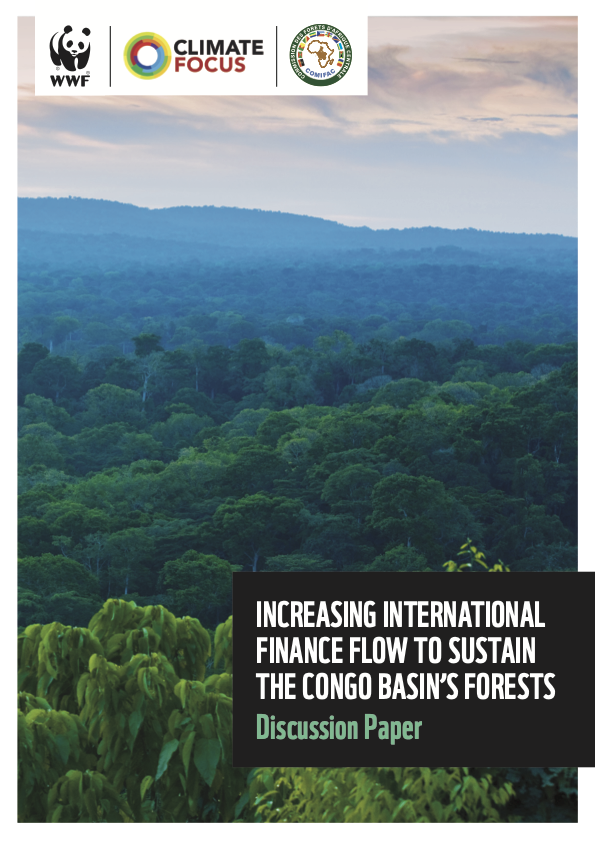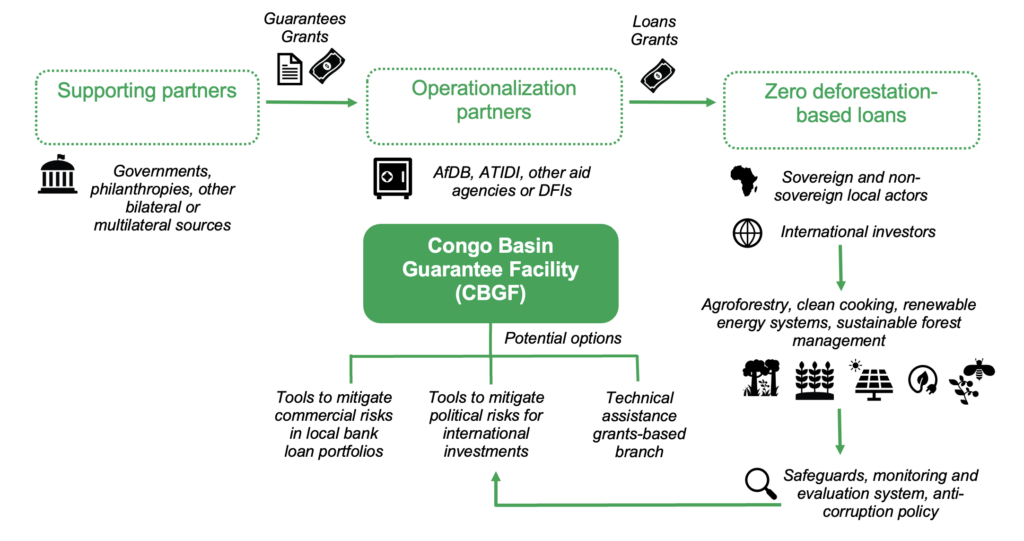The Congo Basin region hosts the world’s largest expanse of high-integrity forests and second-largest tropical forest. Although relatively undisturbed compared to other tropical forests, the Congo Basin is at significant risk today, with deforestation and forest degradation increasing.
Despite the need, finance for forest conservation in the region has been limited.
In a study for WWF and COMIFAC, Climate Focus proposed three overarching strategies to channel additional finance ensuring these conditions to the Congo Basin:
- Reforming the international financial system to value high-integrity forests through public finance,
- De-risking private investments through blended finance approaches, and
- Enhancing environmental markets through private finance.
This blog presents one of the potential strategies to channel additional finance to the Congo Basin through blended finance approaches: financial guarantees.
 WHY AND HOW IS FUNDING LIMITED?
WHY AND HOW IS FUNDING LIMITED?
The Congo Basin received USD 40 million for forest and environmental protection from 2017 to 2021. This amount represents only 4 percent of the USD 1 billion allocated to each of the Amazon and Southeast Asia rainforests during the same period.
Congo Basin countries struggle to secure subsistence and promote economic development while preserving their natural resources. For example, the Democratic Republic of Congo, the second poorest nation in the world, has the tempting alternative to auction oil and gas drilling blocks with a value of at least USD 650 billion, ten times the country’s GDP. However, this approach would impact at least 11.2 million hectares of rainforest, affecting people’s livelihoods and causing other environmental damages.
Similarly, prospective profits generated by agriculture, industrial logging, or mining dwarf any income that can be generated by standing forests. Weak governance, political and social instability, and high levels of public debt also haunt governments in the region. This context leaves little room to enact policies or attract green investments safeguarding their forests – without additional and innovative financial approaches.
BLENDED FINANCE APPROACHES ARE KEY TO CATALYZING PRIVATE CAPITAL
Public funds alone are insufficient to tackle this challenge. Blended finance approaches use public or philanthropic capital to catalyze private investments in projects deemed too risky or financially unattractive. Here we outline how guarantees could cut through the tricky web of obstacles faced by Congo Basin nations.
GUARANTEES ARE UNIQUELY SUITED TO MOBILIZING PRIVATE CAPITAL BY DE-RISKING INVESTMENTS
Guarantees are tools that promise to complete a financial obligation in the event of non-payment from a borrower. One benefit of guarantees is that they are customizable, allowing them to address one or several investment and development priorities.
Additionally, they do not require an immediate funding cash flow and have proven effective in mobilizing private finance and easing credit when facing commercial or credit risks, political risks (i.e., civil disturbances, political unpredictability, contract breaches, expropriation), or operational risks (i.e., result in a shortfall in revenues).
Creating a Congo Basin Guarantee Facility (CBGF) could attract private investments in sustainable forest management, deforestation-free supply chains, or other activities that commit to a zero-deforestation policy.
The CBGF could focus on unlocking two financial barriers in the region by:
- Mitigating commercial risks of lending from financial institutions to local investors with limited access to market capital (such as small and medium-sized enterprises (SMEs), small farm holders, or women-based businesses) to invest in agroforestry, clean cooking, decentralized renewable energy systems, and community-based forest management.
- Mitigating political risks to attract international investments in sustainable forest management, sustainable resource extraction, sustainable tourism, or renewable energy infrastructure projects.
Financial partners could provide partially unfunded guarantees eliminating the need for immediate cash flows and grants for technical assistance. The management of the CBGF could be entrusted to a multilateral development Bank such as the African Development Bank (AfDB), based on its experience with the Africa Co-Guarantee Platform or the African Trade and Investment Development Insurance (ATIDI), a pan-African institution that provides political risk insurance to investments in the region, including through the African Energy Guarantee Facility.
A technical assistance branch might enhance the CBGF effectiveness. This arm could support project preparation and make initiatives financially viable. The scheme could also adopt social and environmental safeguards, a strong conservation monitoring framework with which eligible projects would have to comply, and a strict anti-corruption policy.

While guarantees remain an underutilized instrument in sustainable development, the CBGF could learn from innovative approaches. Examples include the Innovative Finance Facility for Climate in Asia and the Pacific, which uses guarantees to free up capital from the Asian Development Bank’s sovereign loans portfolio or the African Guarantee Fund, which provides access to capital to SMEs.
The CBGF could also build on the long-standing experience of the World Bank’s Multilateral Investment Guarantee Agency which promotes foreign investment through guarantees safeguarding from political risks. The health and education sectors offer interesting recommendations and lessons learned.
Setting up a guarantee facility does have challenges and limitations. It demands specific financial, legal, and risk management skills and can be more complex to structure and operate compared to other instruments.
CONCRETE STEPS CAN FURTHER ASSESS THE POTENTIAL OF A CBGF:
- Identify sectors and business models with high social, economic, and environmental benefits for financing, considering associated risks.
- Assess the risks of local and international investors and financial institutions.
- Evaluate the region’s legal and regulatory framework to ensure it supports the creation and operation of a guarantee system.
- Find a dedicated institution to manage the guarantee system, identify roles, responsibilities, and monitoring and evaluation processes.
- Develop a robust risk assessment methodology to evaluate the viability of projects.
- Design the guarantee system’s financial structure, specify the fund’s size, and identify financial partners.
Engaging with key stakeholders, including potential beneficiaries, governments, financial institutions, and investors from the start, can ensure local priorities are met.
OUR CONCLUSIONS
The Congo Basin forests are at critical risk and blended finance approaches, particularly guarantees, present a strategy to de-risk investments that support conservation efforts. A CBGF can be part of a portfolio of innovative financial approaches needed to address the region’s challenges. But importantly, these approaches must be integrated with green economic practices that ensure sustainable and just livelihoods in the long term.
Read the full report, “Increasing International Finance Flow to Sustain the Congo Basin’s Forests” for more finance mobilization strategies to support conservation efforts of Congo Basin countries.

